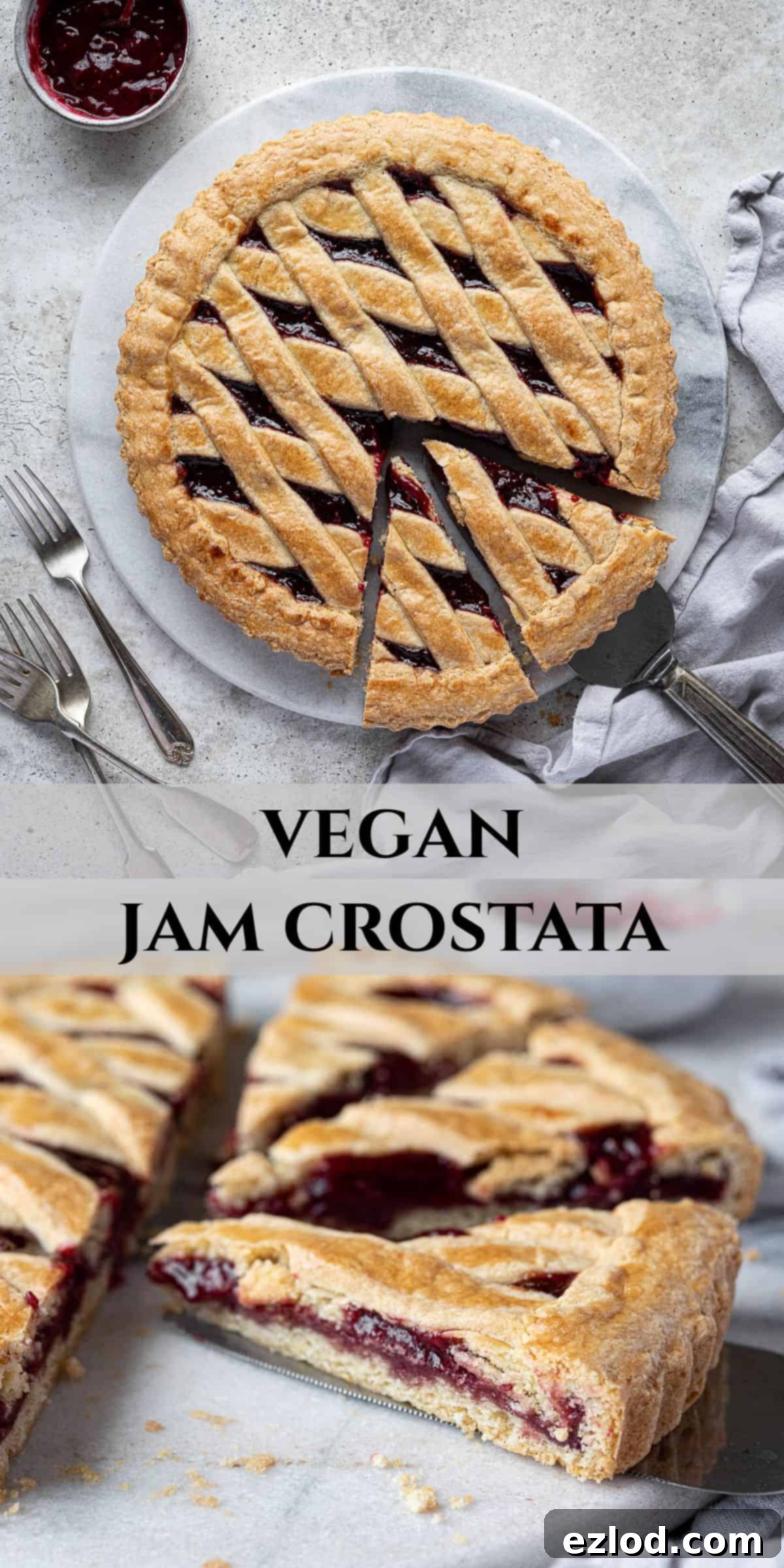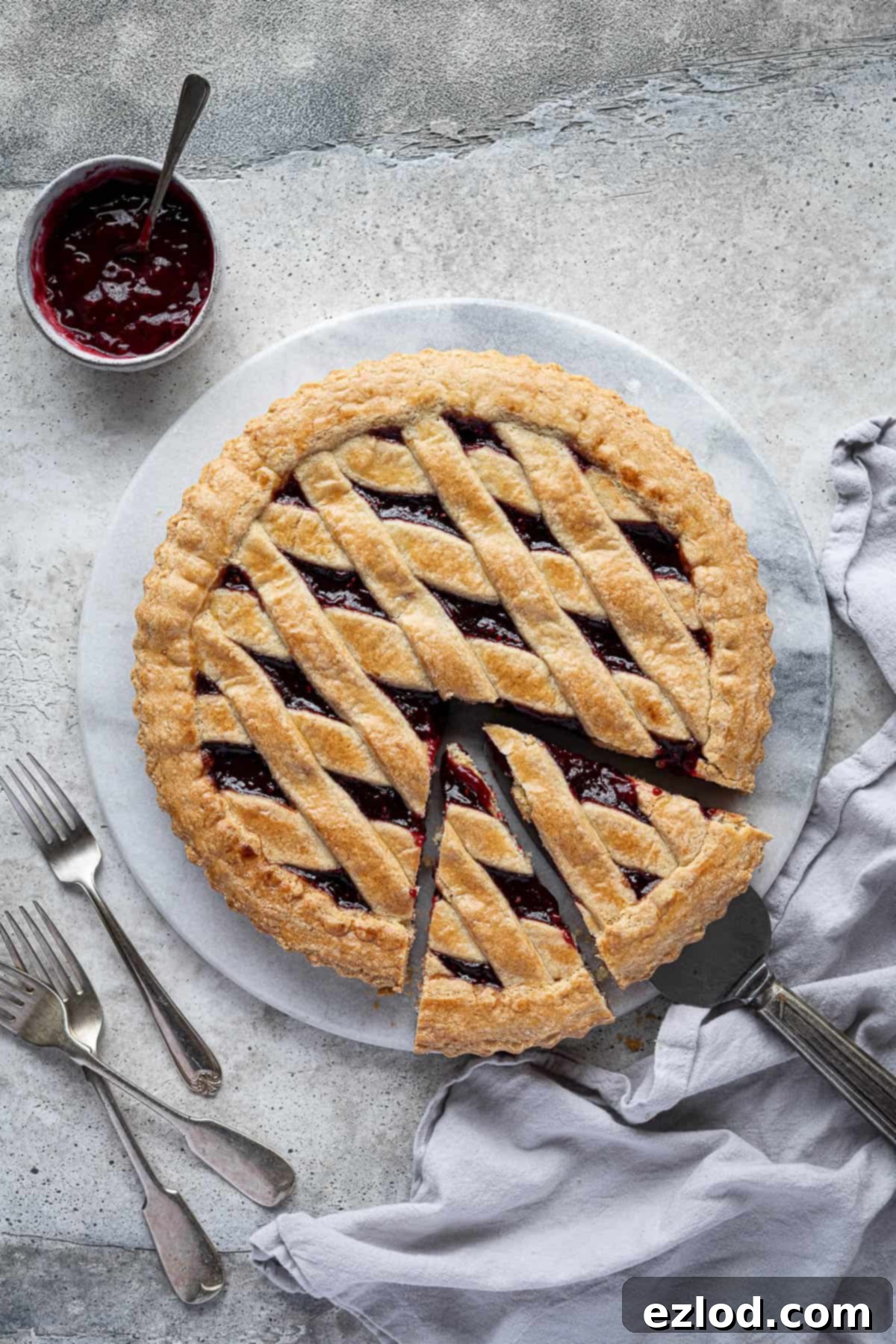Delicious Vegan Jam Crostata: An Easy Plant-Based Italian Tart Recipe
Indulge in the delightful simplicity of a homemade **Vegan Jam Crostata**, a plant-based take on the beloved classic Italian jam tart. This recipe transforms traditional elements into a compassionate and equally delicious dessert, proving that going vegan doesn’t mean sacrificing flavor or texture. With its rich, crumbly pastry and vibrant fruit filling, this crostata is more than just a sweet treat – it’s an experience perfect for any time of day, whether you are observing a vegan diet or simply exploring new and exciting baking options.
Whether you’re hosting a dinner party, preparing a special breakfast, or simply craving a comforting snack with your afternoon coffee, this vegan crostata fits the bill beautifully. It boasts a perfectly crumbly, melt-in-the-mouth texture, a subtly lemon-scented crust, and a sweet, fruity center. The intricate lattice top, a hallmark of traditional crostata, adds an elegant touch that’s surprisingly easy to achieve, making this recipe as visually appealing as it is tasty. Its versatility ensures it’s always a welcome addition to any table.
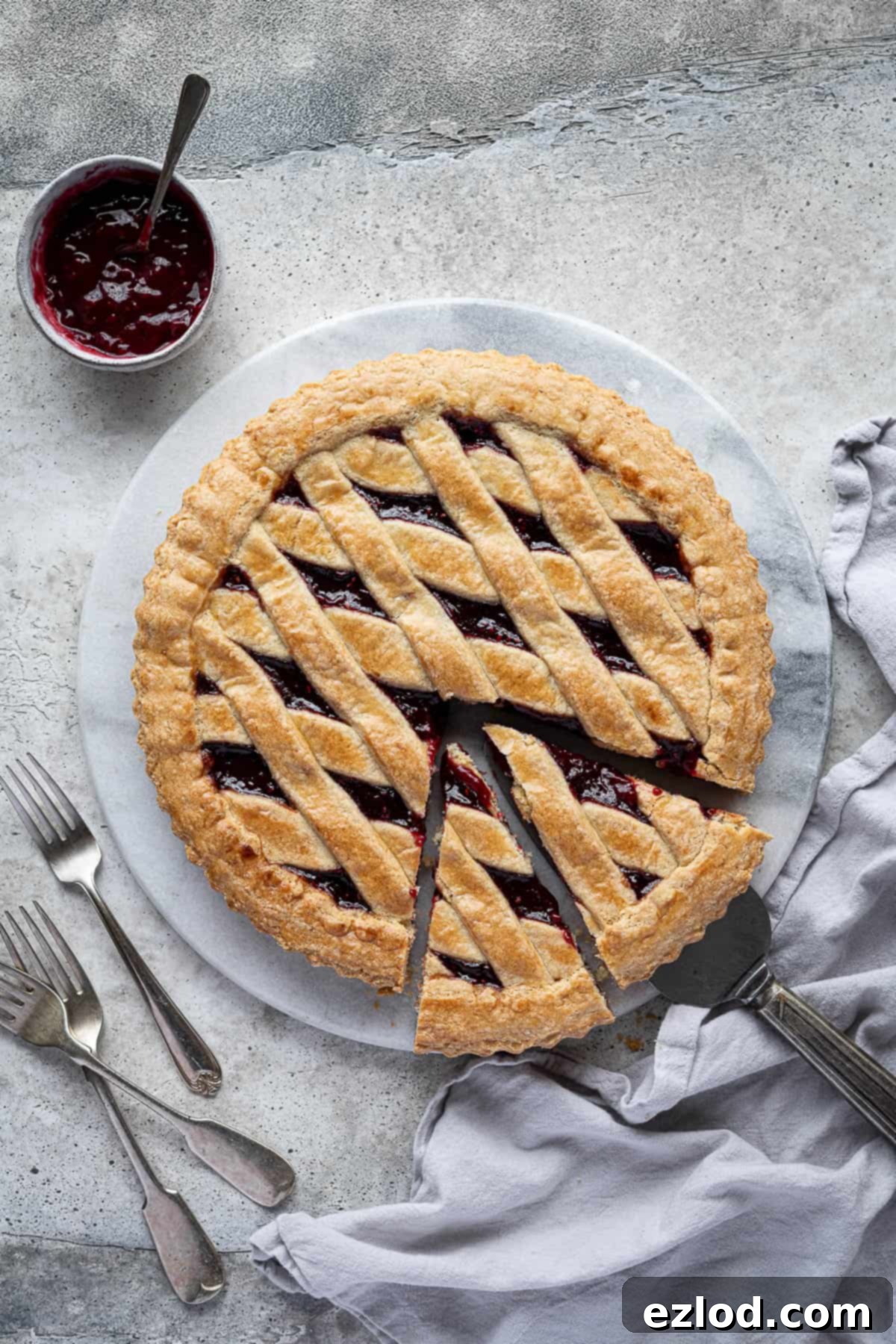
Crafting this vegan jam crostata is far simpler than its elegant appearance suggests. You won’t need an arsenal of gourmet ingredients or advanced baking skills. Instead, this recipe relies on common pantry staples and straightforward techniques, making it accessible for bakers of all levels. The result is a truly satisfying dessert that captures the essence of Italian home baking, re-imagined for a plant-based diet. Prepare to impress your friends and family, and even yourself, with this wonderfully sweet and fruity vegan tart!
What Exactly is Crostata? Exploring the Italian Jam Tart Tradition
At its heart, a **crostata** is a quintessential Italian baked tart, characterized by its rustic charm and delightful simplicity. It’s traditionally made with a special type of Italian shortcrust pastry known as **pasta frolla**. While there are numerous regional variations across Italy, ranging from savory fillings to sweet ones like ricotta, chocolate, or various fruits, the most iconic and universally beloved version is undoubtedly the jam-filled tart, almost always adorned with a decorative lattice top. This lattice is not just for beauty; it also allows the jam to peek through and caramelize slightly during baking.
What sets pasta frolla apart from standard shortcrust pastry? Typically, traditional pasta frolla incorporates eggs and a touch of baking powder, which contributes to a distinctly lighter, softer, and more tender texture compared to its English or French counterparts. It also tends to be slightly sweeter, providing a perfect complement to the often-tart fruit fillings. Our vegan interpretation cleverly substitutes these animal-derived ingredients while maintaining the authentic characteristics of pasta frolla, ensuring that the crust remains crumbly, rich, and truly melt-in-your-mouth.
Crostata isn’t just a dessert; it’s deeply woven into Italian culinary traditions and enjoyed throughout the day. It’s commonly served for **breakfast**, providing a sweet and satisfying start to the morning alongside a strong espresso or cappuccino. It also makes for an excellent **afternoon snack** (merenda), a delightful accompaniment to coffee or tea, offering a comforting pause in the day. And, of course, it shines as a simple yet elegant **dessert** after any meal, often served as is or with a scoop of creamy vegan gelato. Our vegan interpretation ensures that everyone can partake in this timeless Italian tradition, offering the same beloved flavors and textures without any animal products.
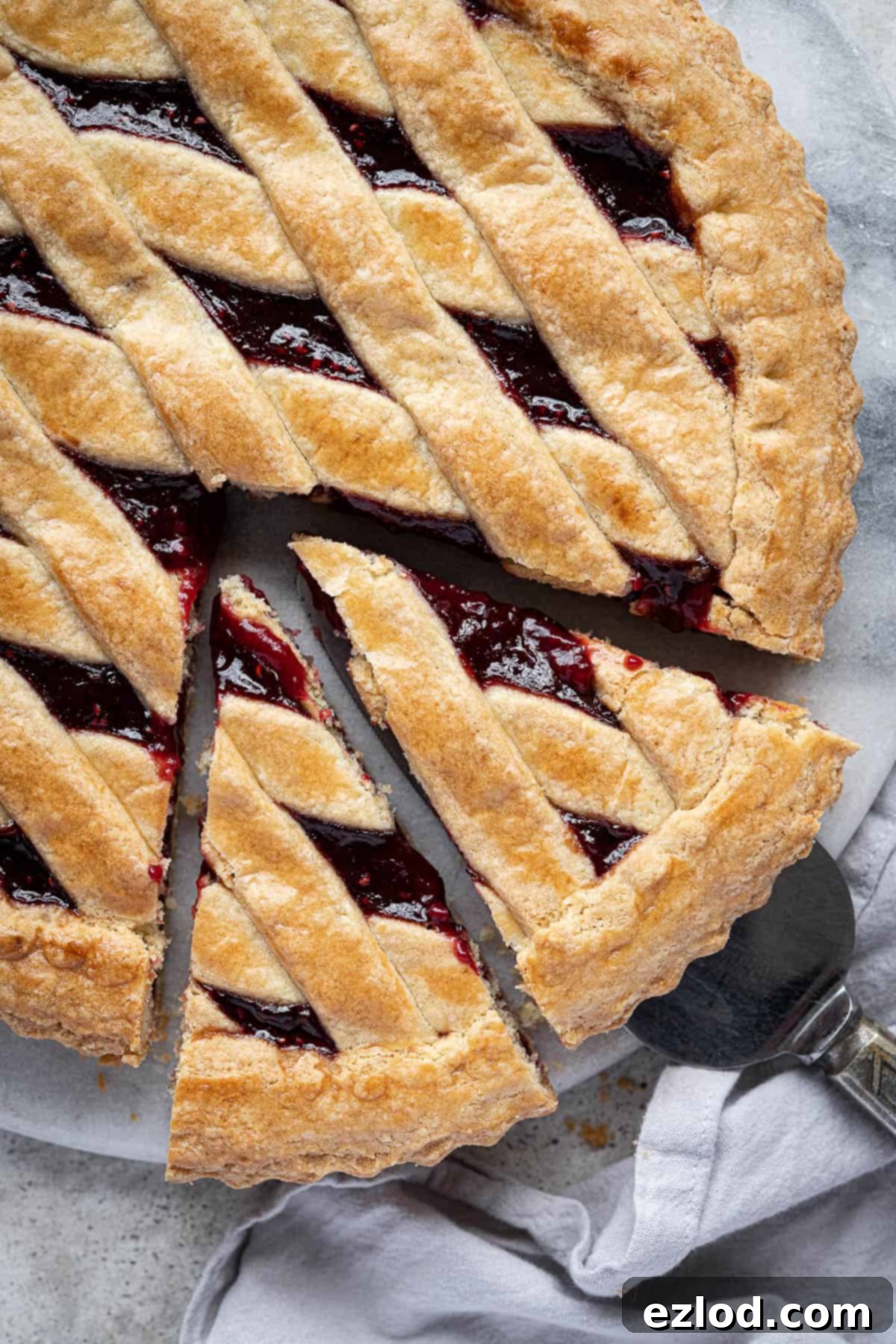
Essential Ingredients for Your Vegan Jam Crostata
Creating this delicious vegan jam crostata is straightforward, requiring a selection of accessible ingredients that you likely already have or can easily find. The key to success lies in understanding the role each component plays in achieving that perfect crumbly crust and flavorful filling. Here’s a detailed look at what you’ll need, along with tips for best results:
Quality Jam: The Heart of Your Crostata
The star of this tart is undoubtedly the **jam**. Since it’s the primary filling ingredient, its quality and flavor are paramount. Choose a high-quality jam that you genuinely love – whether it’s a gourmet store-bought brand or a vibrant homemade preserve. While I opted for the delightful tartness of raspberry jam for this recipe, many other fruit flavors would be equally fantastic. Consider apricot, strawberry, peach, mixed berry, or even cherry jam. The choice is yours, so pick a flavor that excites your palate! It’s important to use a jam with a good consistency – ideally not too runny, as this can lead to a soggy bottom, and not excessively thick, which might make it difficult to spread evenly. If your jam is very thick, a quick gentle warm on the stove can make it more workable.
Plain (All-Purpose) Flour: The Foundation of Your Pastry
You’ll need regular **plain (all-purpose) flour** for the pastry. This type of flour provides the right balance of protein to create a tender, yet workable dough that can be easily rolled out and shaped without excessive elasticity. For those wondering about gluten-free options, I haven’t personally tested this specific recipe with gluten-free flour blends. However, if you decide to experiment, look for a reputable gluten-free all-purpose baking blend, and be prepared to potentially adjust the liquid content slightly, as GF flours can absorb moisture differently.
Baking Powder: The Secret to a Light and Tender Crust
One of the distinguishing features of traditional pasta frolla, and therefore our vegan version, is the inclusion of **baking powder**. Unlike many standard shortcrust pastries that rely solely on fat for tenderness, baking powder helps to create a lighter, softer, and more delicate texture in the finished crust. It provides a subtle lift, contributing to that delightful melt-in-your-mouth quality, making the crostata less dense and more enjoyable to eat. Don’t omit this crucial ingredient.
Vegan Block Butter: Crucial for Structure and Flavor
This is a critical ingredient where precision and type matter significantly. You **must** use a solid **block vegan butter or margarine**, not the spreadable kind that typically comes in a tub. Spreads usually contain a much higher water content and lower fat percentage, which will negatively affect the pastry’s structure, making it too soft, sticky, and incredibly difficult to handle and roll out. Brands like Naturli vegan block or Flora plant butter (specifically in block form) are excellent choices that mimic the properties of dairy butter perfectly for baking. Ensure your vegan butter is very cold and cut into small cubes before you begin, as this helps create a flaky texture.
Non-Dairy Milk (or Water): The Essential Binder
A small amount of **cold non-dairy milk** (or even plain cold water) is used to bring the pastry dough together. This replaces the eggs found in traditional pasta frolla and helps create a cohesive dough that can be formed and rolled. Using cold liquid is paramount, as it helps keep the vegan butter firm, which is key for developing a tender, flaky crust. Any plain, unsweetened non-dairy milk will work well – oat, almond, soy, or cashew milk are all good options. Start with the minimum amount specified and add more gradually, only until the dough just comes together, to avoid making it too sticky.
Fresh Lemon Zest: A Burst of Fragrance and Brightness
The addition of **finely grated lemon zest** is a game-changer for this crostata, infusing the pastry with a beautiful, fragrant aroma and a subtle bright, citrusy flavor. This zest perfectly complements the sweetness of the jam, adding a layer of complexity and freshness that elevates the entire experience. Always use fresh lemon zest for the best flavor; avoid bottled versions as they lack the vibrant essential oils.
Caster Sugar (Superfine Sugar): For Balanced Sweetness and Tenderness
**Caster sugar** (also known as superfine sugar) is my preferred choice for this recipe due to its finer grain. This allows it to dissolve easily into the dough, contributing to a smooth, tender pastry without a grainy texture. However, standard granulated sugar will also work perfectly fine if that’s what you have on hand. The sugar not only sweetens the crust but also aids in achieving a lovely golden-brown color during baking and contributes to its overall delicate, crumbly texture.
Pinch of Salt: Flavor Enhancer and Balancer
A small but mighty **pinch of salt** might seem minor, but it plays a vital role in balancing the sweetness of both the sugar in the pastry and the jam filling. It enhances all the other flavors in the dough, preventing the crostata from tasting one-dimensionally sweet. It’s a fundamental ingredient in most baking recipes for a reason – it rounds out the flavor profile beautifully.
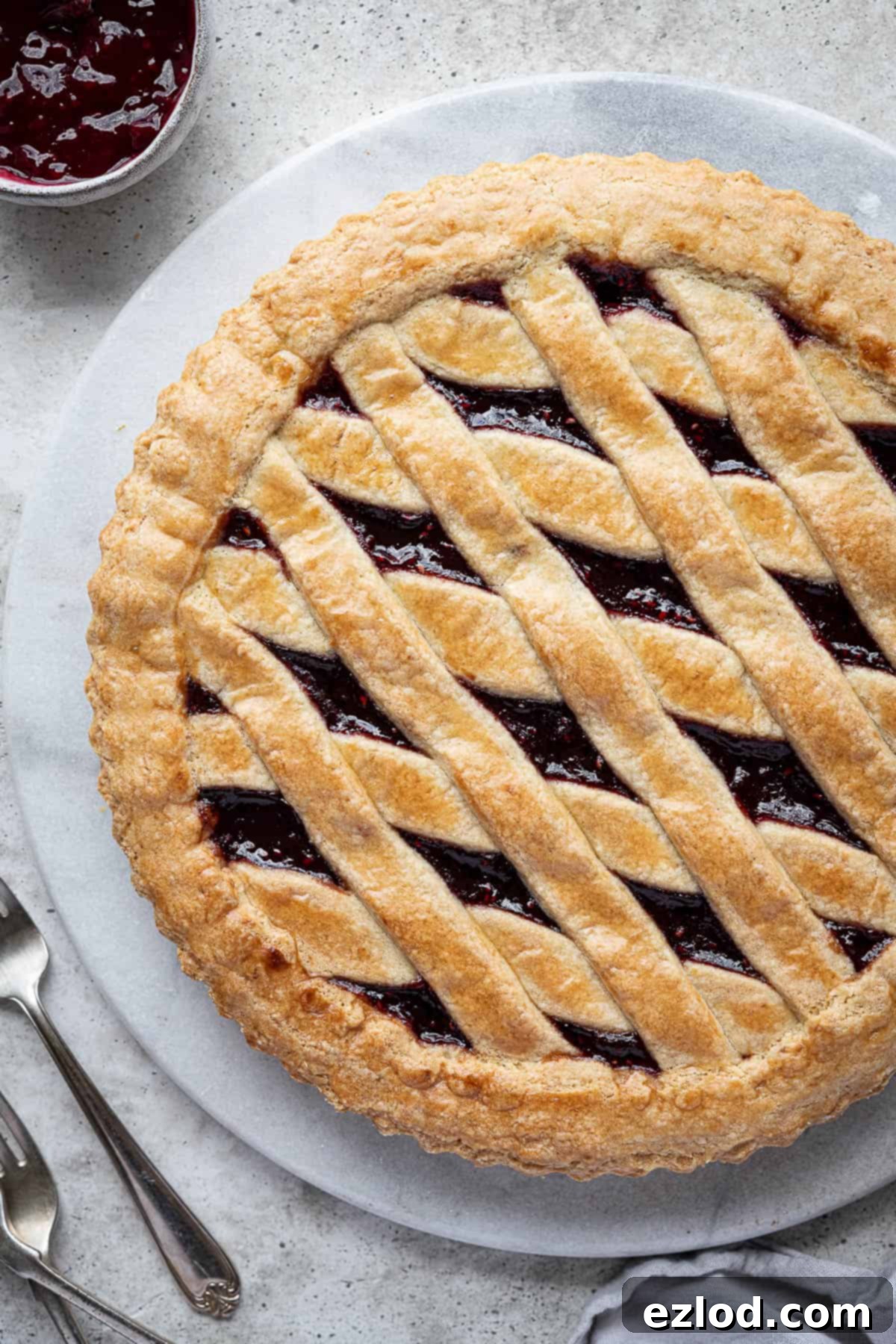
Step-by-Step Guide: How To Make Your Vegan Jam Crostata
(For precise measurements and full instructions, please refer to the comprehensive recipe card located at the bottom of this page.)
Making a delicious vegan jam crostata involves a few key steps, primarily focusing on creating the perfect pastry dough and then assembling the tart with care. Follow these detailed instructions carefully for the best results and a truly beautiful Italian dessert:
1. Prepare the Pastry Dough Base
Begin by combining all your dry ingredients in a spacious mixing bowl. Add the plain (all-purpose) flour, baking powder, caster (superfine) sugar, and a pinch of salt. Crucially, add the finely grated zest of one large lemon; give everything a good whisk or mix with a spoon to ensure it’s thoroughly and evenly distributed. The lemon zest will infuse the pastry with a wonderful, fragrant aroma and a bright, fresh flavor that is characteristic of good crostata.
Next, introduce the very cold, cubed vegan block butter. Using your fingertips, gently rub the butter into the dry ingredients. This technique is similar to making traditional shortcrust pastry. Work quickly and with light hands to prevent the butter from warming up too much from the heat of your hands. Continue rubbing until the mixture resembles fine breadcrumbs, and no large lumps of butter remain. This step is crucial for achieving that signature crumbly and tender texture in the baked crostata.
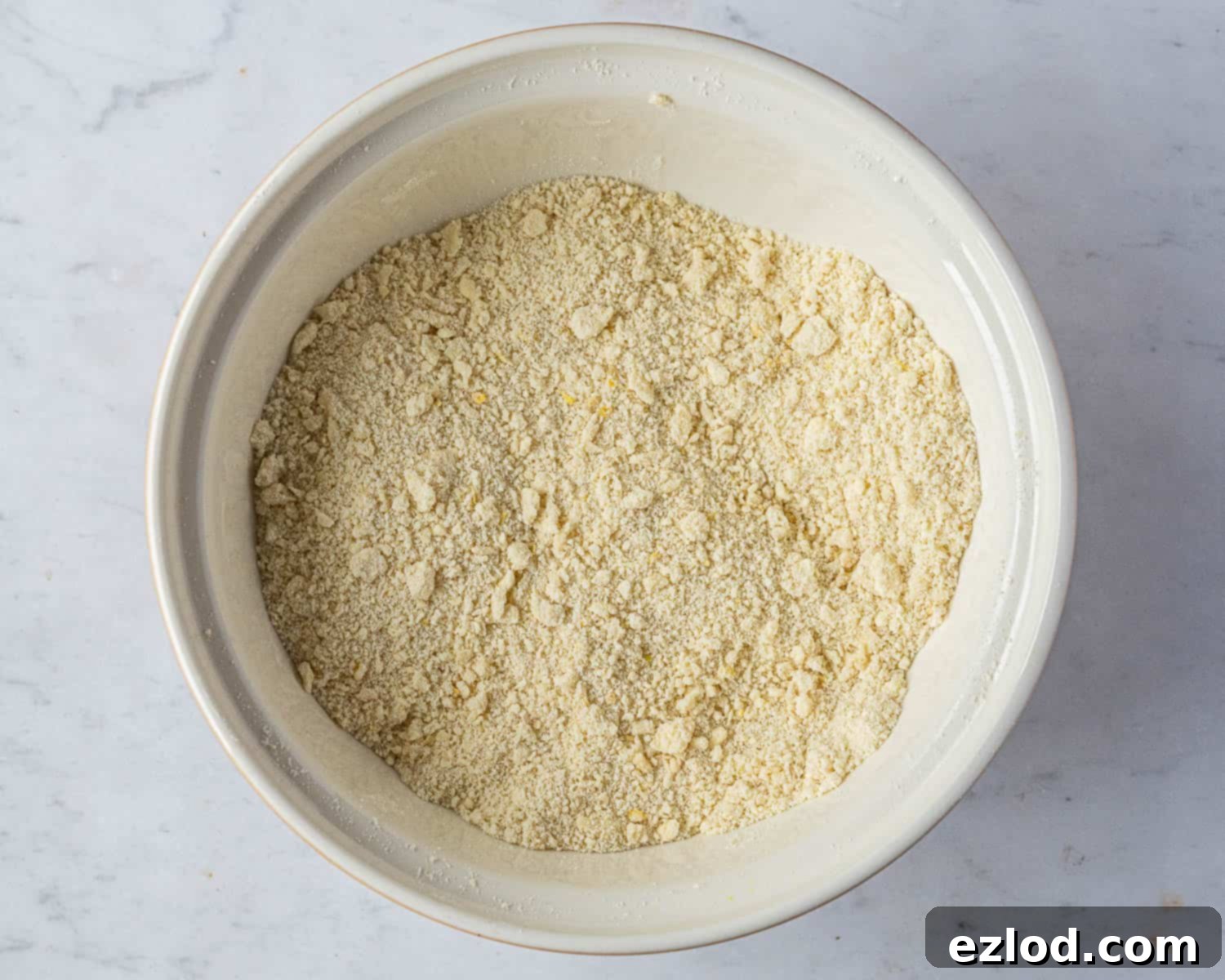
2. Form and Chill the Dough Properly
Gradually add the cold non-dairy milk (or cold water), a tablespoon at a time, mixing it into the flour and butter mixture. Use your hands to gently bring the dough together into a cohesive ball. It’s important not to overmix or knead the dough excessively, as this can develop the gluten in the flour and result in a tough, rather than tender, pastry. Once formed, gently flatten the dough into a disc shape, wrap it tightly in cling film or reusable food wrap, and refrigerate it for at least one hour. This chilling period is absolutely vital; it allows the gluten to relax, which prevents shrinkage during baking, and more importantly, allows the butter to firm up again, making the pastry much easier to roll out without sticking or tearing.
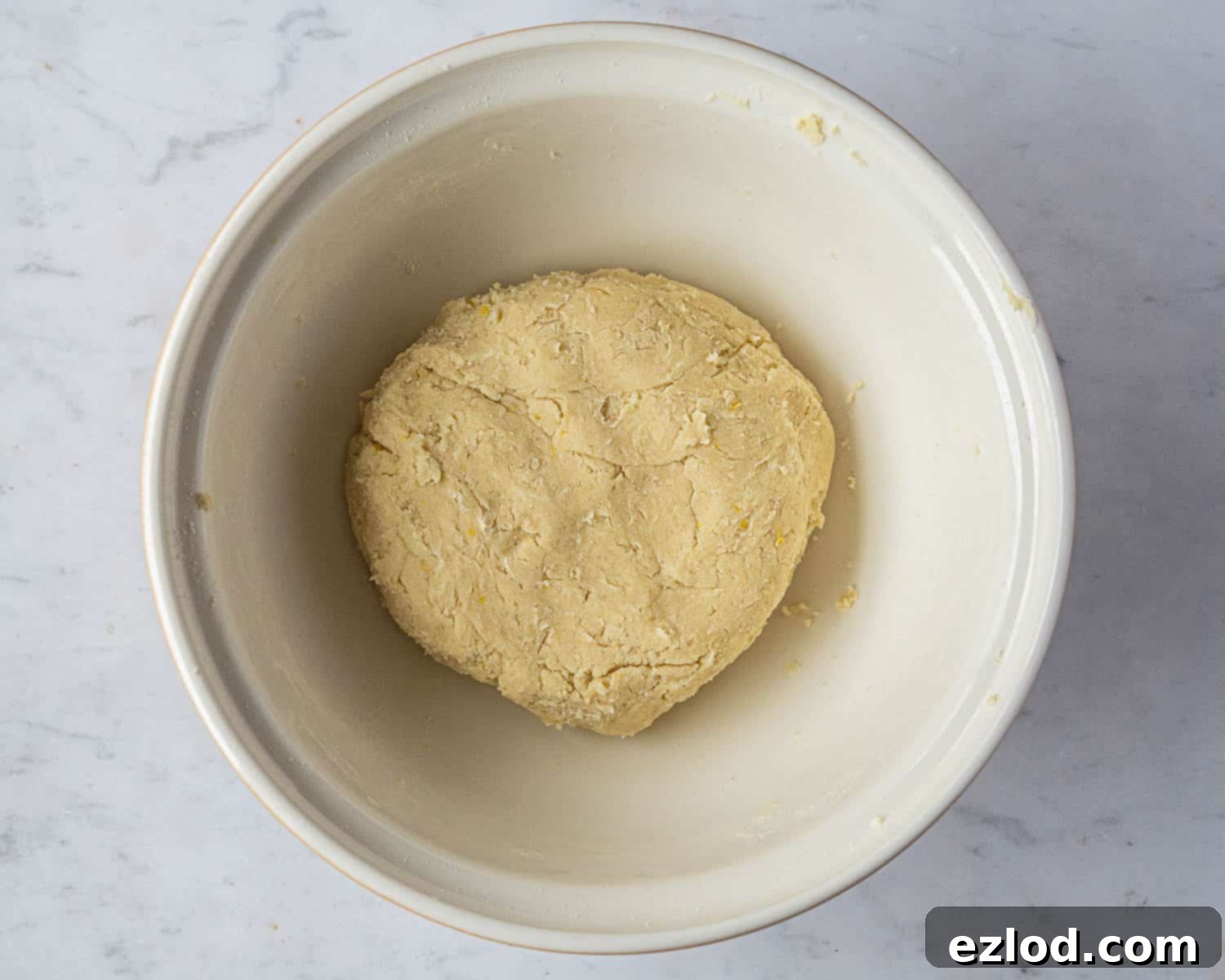
3. Line the Tart Tin with Care
Once your pastry has chilled sufficiently and is firm to the touch, remove it from the fridge. Cut off approximately one-quarter of the dough and immediately return this smaller portion to the fridge – this will be used later for the decorative lattice top. On a lightly floured surface, roll out the larger portion of pastry into a generous round, aiming for a thickness of about ½ cm (¼ inch). Ensure the diameter is large enough to comfortably cover your approximate 25cm/10 inch round loose-bottomed tart tin with some overhang around the edges.
Carefully transfer the rolled-out pastry into the tart tin. This can be done by gently rolling it around your rolling pin and unrolling it over the tin, or by folding it into quarters and unfolding it in the tin. Gently press the pastry into the base and up the sides, ensuring it fits snugly into all the corners of the tin without stretching it. Use a sharp knife or a pastry wheel to neatly trim off any excess pastry from the edges, leaving a clean, even crust. Don’t discard these pastry scraps; they can be combined with the reserved pastry for the lattice.
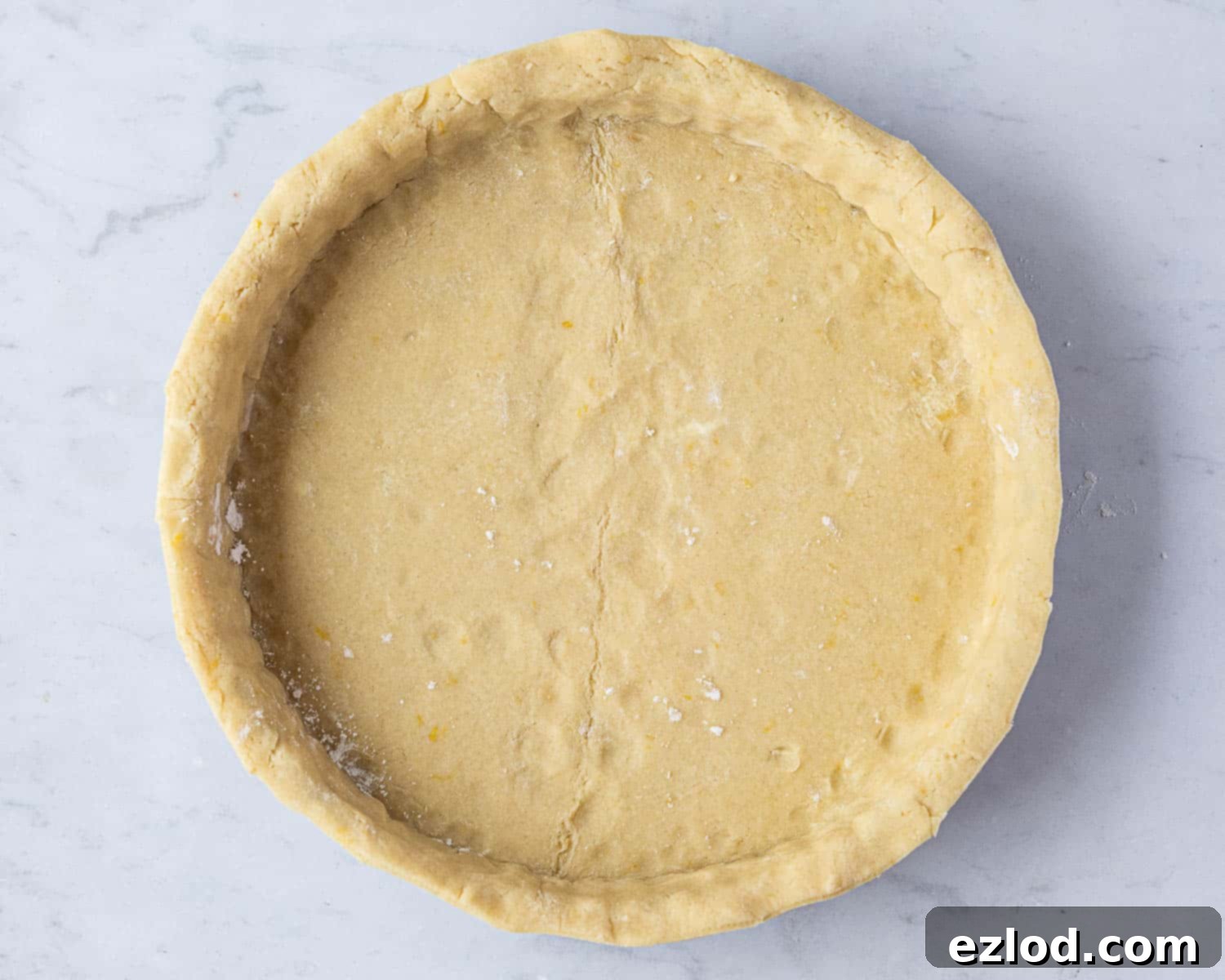
4. Create the Elegant Lattice Strips
Retrieve the reserved pastry dough and any scraps from trimming the base. Combine them gently and knead minimally just until they come together. Lightly flour your work surface again and roll out this combined pastry to a thickness similar to the base, about ½ cm (¼ inch). Using a pizza wheel, a specialized dough cutter, or a sharp knife, carefully slice the pastry into 10 even strips. Aim for uniform width (e.g., about 1-1.5 cm or ½ inch wide) as this will make your lattice pattern look more professional and aesthetically pleasing on top of your crostata.
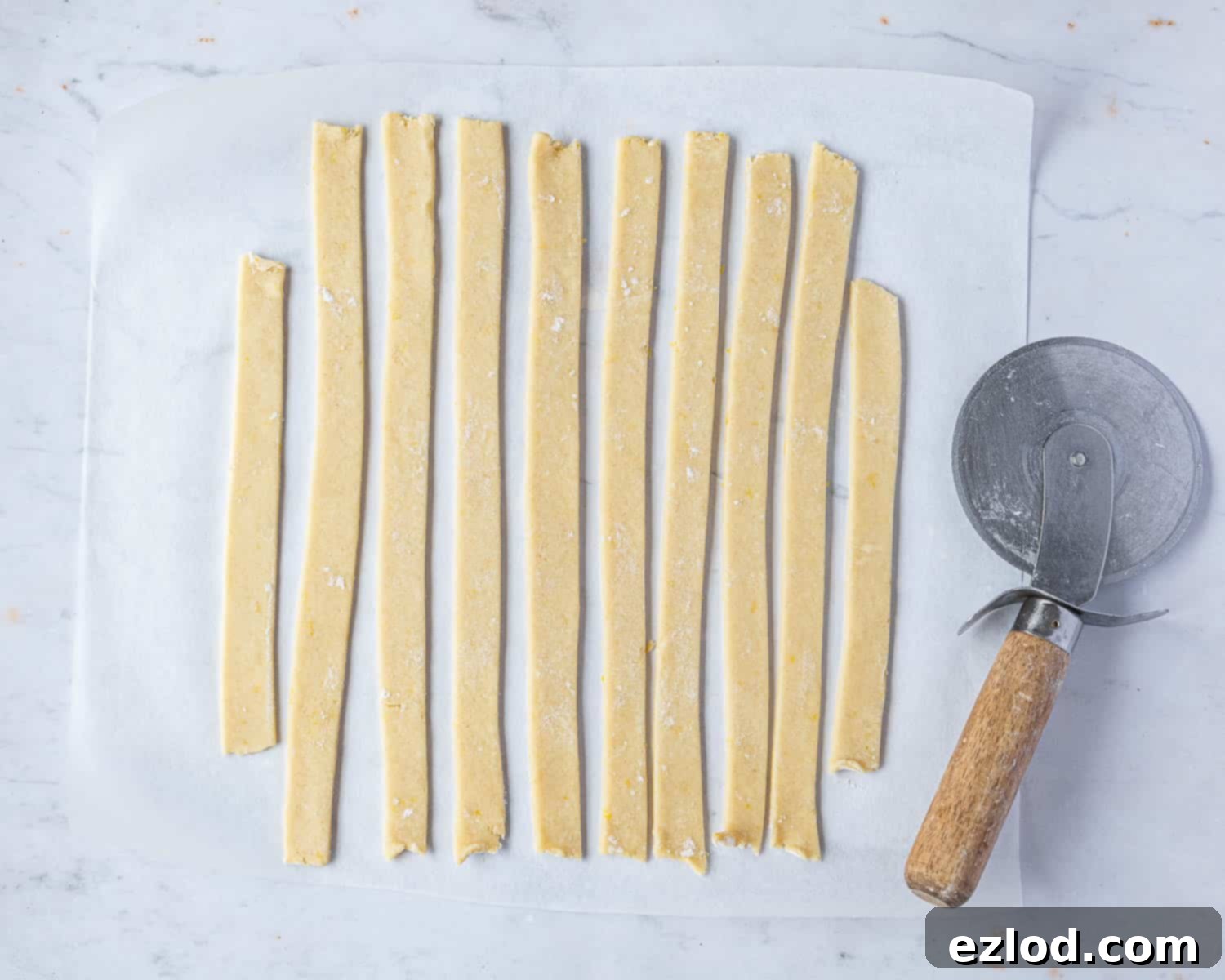
5. Assemble the Crostata with Jam and Lattice
Pour your chosen good-quality jam into the pastry-lined tart case, spreading it evenly to cover the entire bottom of the crust. Ensure the layer is relatively even to allow for consistent baking. Now, it’s time to begin creating the beautiful lattice pattern. Lay five of the pastry strips horizontally across the jam-filled tart, spacing them evenly apart. Do not press them down firmly yet, as you will need to manipulate them for weaving.
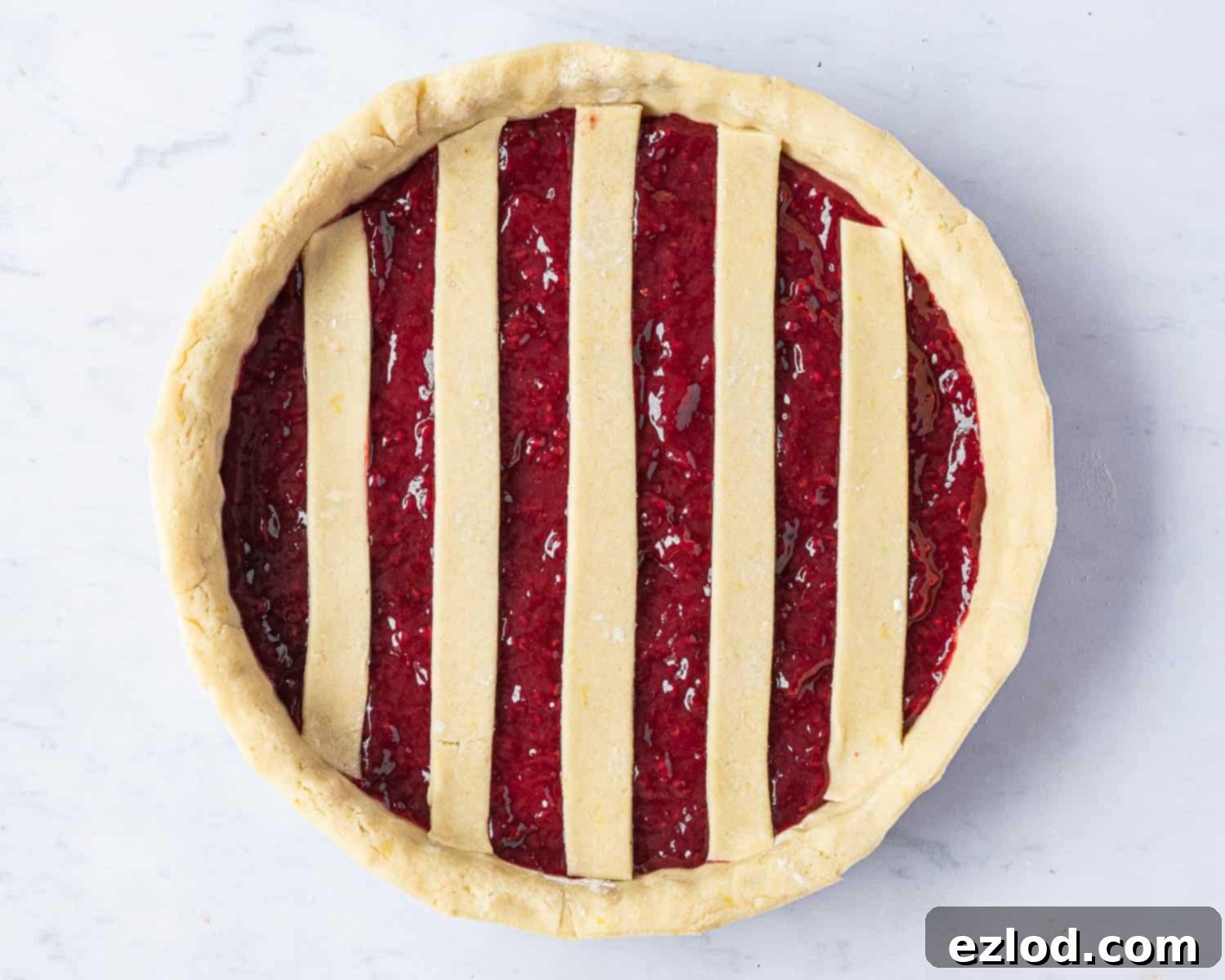
To weave the lattice, take the remaining five strips and prepare to lay them vertically. Start by folding back every other horizontal strip (e.g., the 1st, 3rd, and 5th strips). Place one vertical strip down the center, then unfold the horizontal strips over it. Next, fold back the *other* horizontal strips (the 2nd and 4th), place another vertical strip beside the first one, and unfold those horizontal strips over it. Continue this ‘over and under’ method, alternating which horizontal strips you fold back, until all ten strips are intricately woven into a beautiful lattice pattern over the jam. It creates a striking visual effect that is surprisingly simple to master.
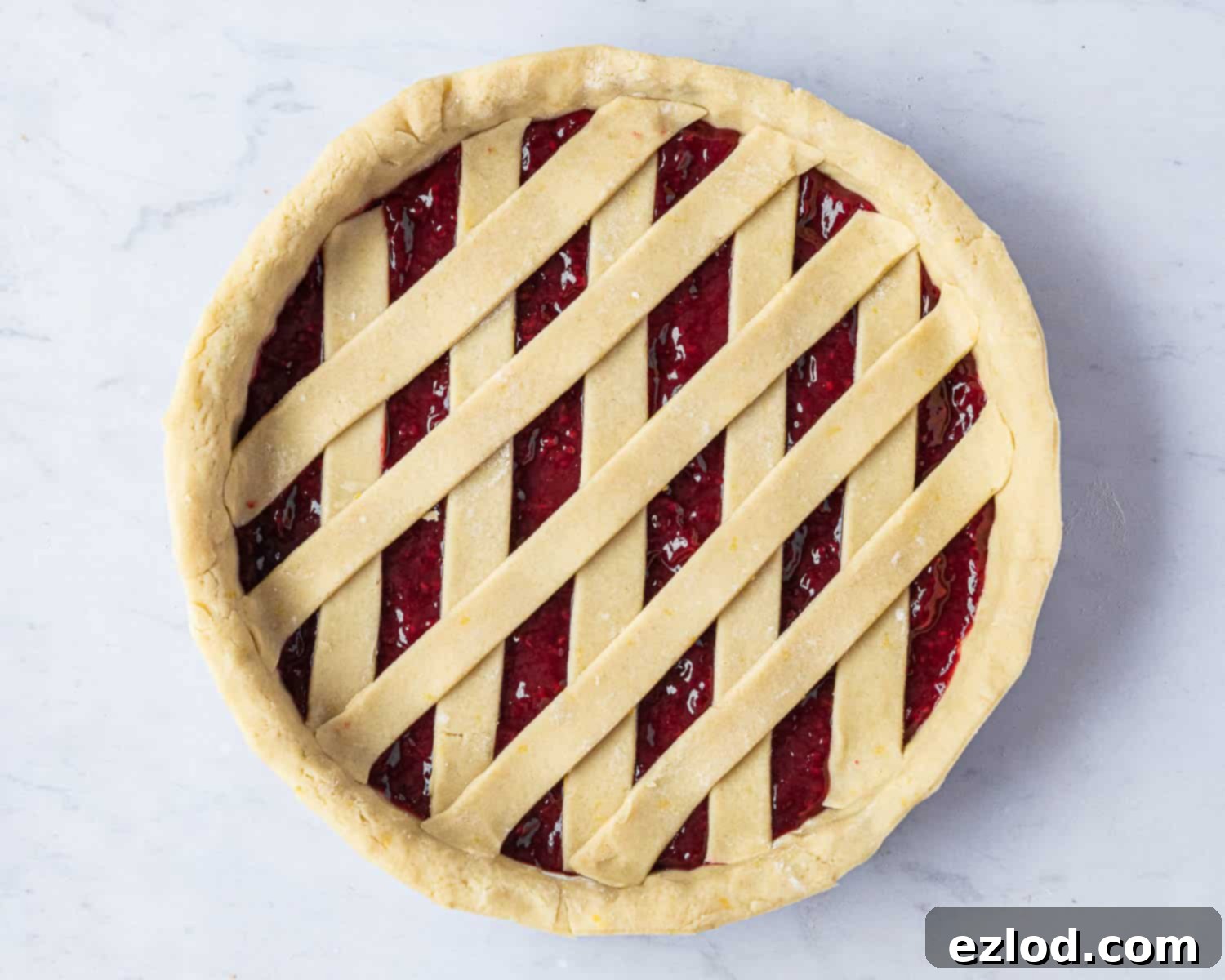
6. Finish and Chill Before Baking for Best Results
Once your lattice is complete and you’re happy with its appearance, trim the ends of all the pastry strips so they are flush with the outer edge of the tart base. Then, carefully fold the excess edge of the base pastry over the ends of the lattice strips, gently pressing them to seal them in. This creates a neat, decorative border and securely anchors the lattice in place, preventing it from lifting during baking. For optimal baking results, place the fully assembled crostata back into the fridge or freezer for a final chill of 15 minutes. During this time, preheat your oven to 180°C/160°C fan/350°F/gas mark 4. This final chill is crucial as it helps the pastry firm up, preventing it from shrinking excessively and ensuring it holds its beautiful shape during the baking process.
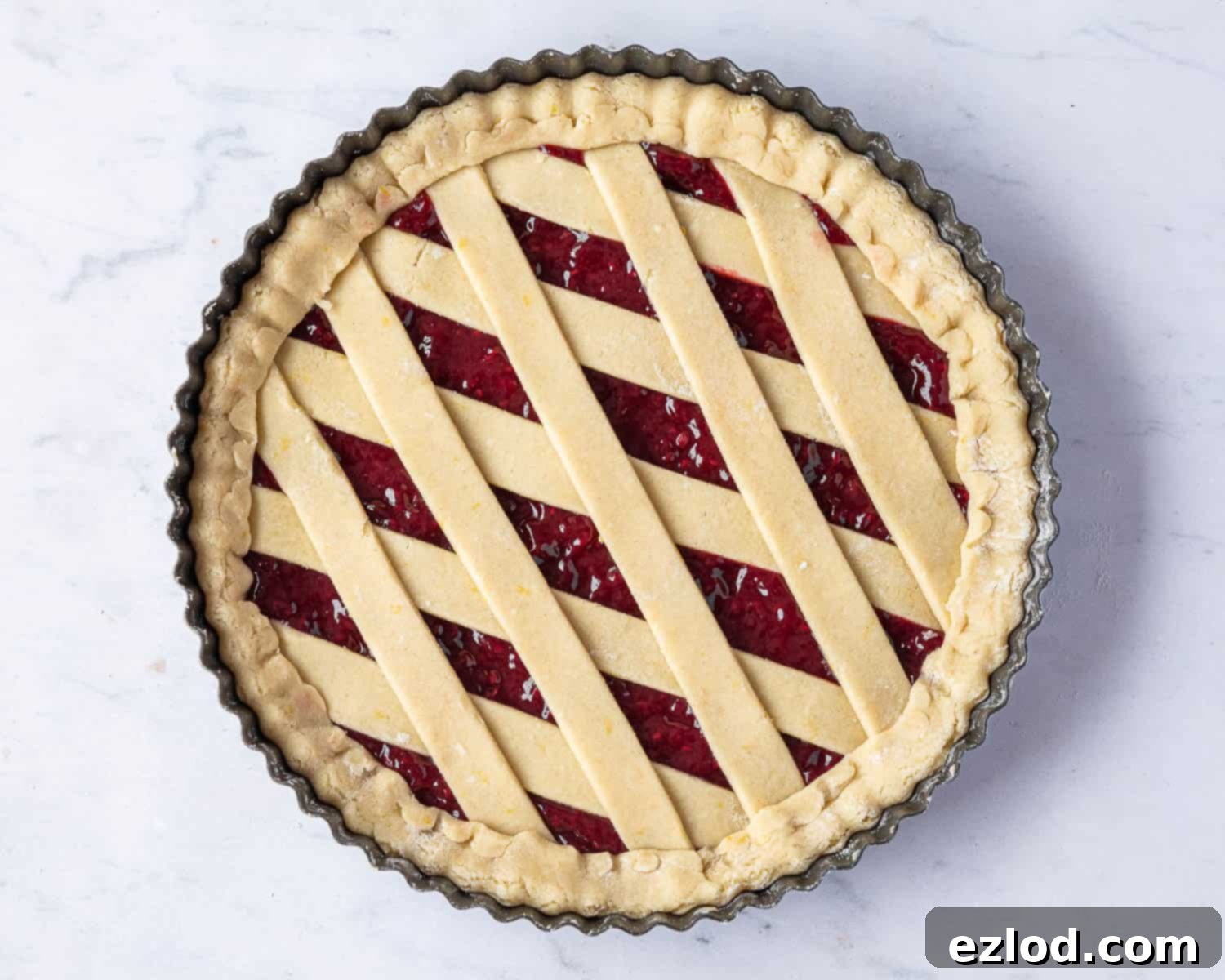
7. Bake to Golden Perfection and Cool
Before placing the chilled crostata in the preheated oven, gently brush the exposed pastry (the lattice and the outer edge of the crust) with a little non-dairy milk. This simple step is vital as it helps achieve that beautiful deep golden-brown color and a lovely subtle sheen on the baked crust. Bake for approximately 35-40 minutes, or until the pastry is richly golden-brown and the jam filling is bubbling gently. Keep a close eye on it during the last 10-15 minutes to ensure it doesn’t over-brown, especially if your oven has hot spots.
Once baked to perfection, carefully remove the crostata from the oven. It’s important to allow it to cool in the tin for about 30 minutes before attempting to move it. This initial cooling period is crucial as it allows the hot jam filling to set further and the pastry to firm up, making it much easier to handle without the risk of breaking or the filling spilling. After 30 minutes, carefully transfer the crostata from the tin to a wire rack to cool completely. Patience is a virtue here; slicing it while still warm might cause the filling to spill and the delicate pastry to break apart. A fully cooled crostata will have the best texture and hold its shape beautifully.
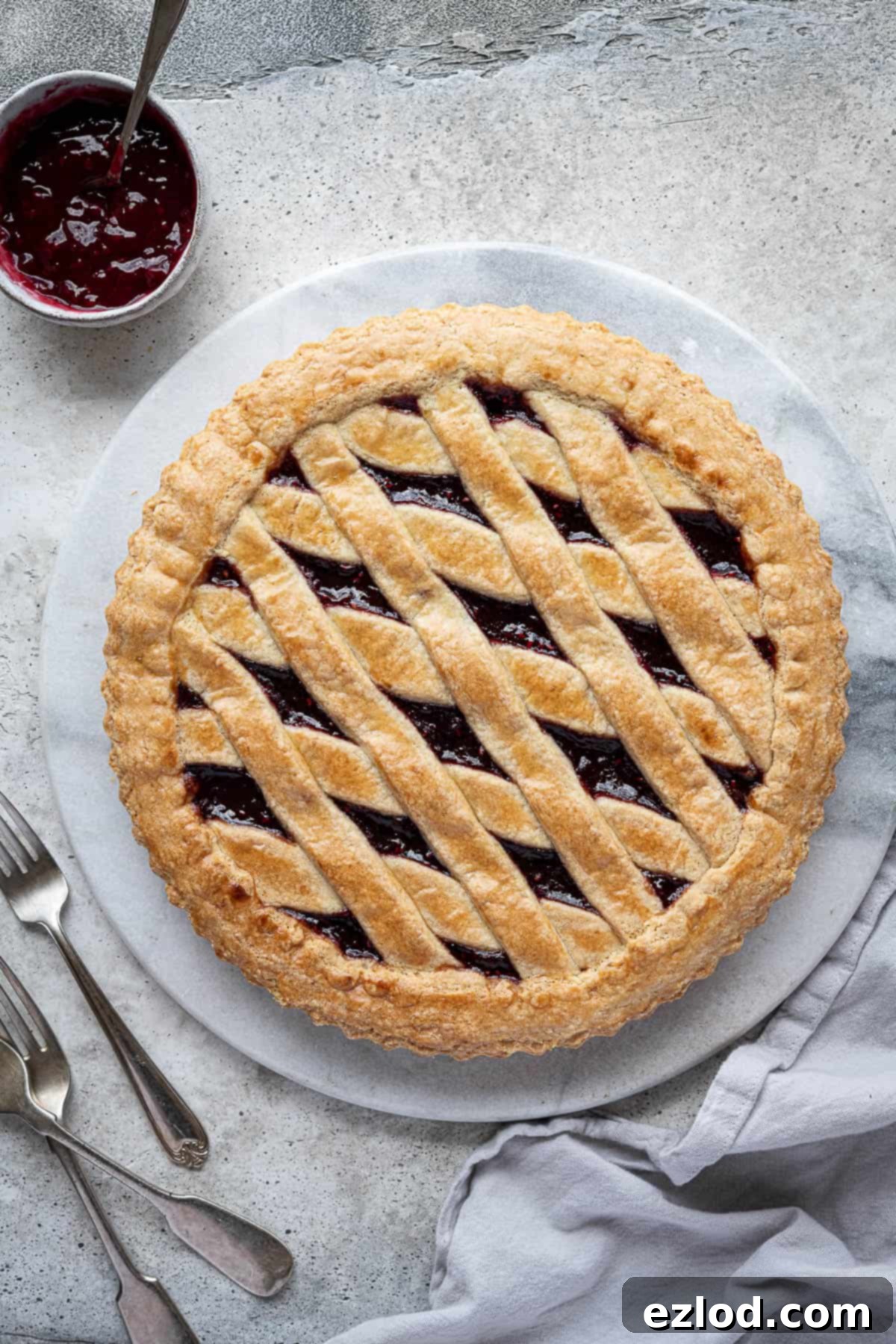
Top Tips for the Perfect Vegan Crostata Every Time
Achieving a show-stopping vegan jam crostata is all about a few tried-and-true techniques and considerations. Here are some expert tips to ensure your tart turns out perfectly golden, crumbly, and delicious every single time:
Accuracy in Measurements: Embrace the Digital Scale!
As with all baking, precision is paramount, and it’s especially true when working with pastry. All my recipes are meticulously developed using grams, and I cannot stress enough the importance of using a **digital kitchen scale** for metric measurements rather than volumetric cup conversions. Cups are notoriously inaccurate due to varying compaction levels and inherent differences in the weight of dry ingredients (e.g., a cup of flour can weigh differently depending on how it’s scooped). Using a digital scale will consistently yield far better, more reliable, and ultimately more successful results. Plus, it’s often less messy and quicker than fussing with multiple measuring cups!
The Non-Negotiable Importance of Chilling the Pastry
Never, ever skip the chilling step for your pastry dough! It is absolutely vital to chill your dough not once, but twice (after mixing and before baking). If the dough is too warm, the vegan butter will be soft and pliable, making the pastry extremely sticky, difficult to handle, and highly prone to tearing when you try to roll it out. Chilling allows the butter to firm up completely and gives the gluten in the flour time to relax. This results in a more pliable, manageable dough that rolls out beautifully, holds its shape during assembly, and prevents excessive shrinkage in the oven. If your kitchen is particularly warm, you might even consider chilling the dough for an extra 30 minutes beyond the recommended time, or returning it to the fridge briefly if it starts to become too soft while you’re working with it.
Prepare Ahead: Making Dough in Advance for Convenience
This crostata recipe is wonderfully suited for planning ahead, making it perfect for entertaining or busy schedules! The pastry dough can be prepared entirely in advance and stored, well-wrapped in cling film or an airtight container, in the fridge for up to two days. This means you can get a head start on your baking, tackling the dough on one day and assembling/baking the tart on another. If the dough becomes too firm to roll out directly from the fridge after extended chilling, simply let it sit at room temperature for about 30 minutes to an hour before you begin rolling. This will allow it to soften slightly, becoming more workable without becoming too warm and sticky.
Storage and Optimizing Freshness
While this vegan jam crostata is undeniably at its absolute best when enjoyed on the day it’s baked – with its crisp crust and fresh, bubbling jam – it will still keep beautifully for a couple of days. Store any leftovers in an airtight container in the fridge for 2-3 days. You can enjoy slices cold directly from the fridge for a quick snack, or for a revived, ‘just-baked’ experience, gently warm individual slices in a toaster oven or conventional oven for a few minutes until the pastry is crisp and the jam is warm again. Avoid microwaving, as this can make the pastry soft and unappealing.
Jam Selection: Don’t Compromise on Flavor or Consistency
The beauty of a jam crostata lies in its relative simplicity, which means the quality of your jam filling is paramount. Opt for a good quality store-bought jam that you adore, or, even better, use a homemade one for the most exquisite and vibrant flavor. Beyond flavor, consider the consistency: a jam that’s too watery can lead to a soggy bottom crust, while one that’s excessively thick might be hard to spread evenly and could even burn in spots. If your chosen jam is very thick, you can gently warm it slightly in a saucepan over low heat to make it more spreadable before filling the tart. If it’s too runny, reducing it slightly on the stove can help thicken it.
Beyond Jam: Explore Other Delicious Vegan Fillings
While jam is the traditional and beloved filling for crostata, feel free to experiment and personalize your tart with other delightful vegan fillings! A rich, decadent vegan chocolate hazelnut spread (like a plant-based Nutella) can be a truly indulgent alternative. You could also try a homemade fruit curd, ensuring it’s made with plant-based ingredients to keep it vegan, for a tangier profile. A combination of jam and fresh fruit (like sliced apples or berries) or even a spiced apple filling can create a wonderful seasonal twist. The robust and versatile pastry base can accommodate a wide variety of sweet fillings, allowing you to customize your crostata to your heart’s content and suit any occasion.
Preventing a Soggy Bottom: Key Strategies
A soggy bottom crust is a common pitfall in tarts, but it’s entirely preventable with a few simple strategies. First, ensure your jam isn’t overly liquid. If you’re using a very juicy homemade jam or a thinner store-bought variety, you might want to gently reduce it slightly on the stovetop before filling the crostata to remove excess moisture. Second, the crucial chilling steps for the pastry dough (especially the final chill before baking) help the butter solidify, creating a barrier against moisture from the filling. Third, baking at the correct oven temperature ensures the pastry cooks through quickly and crisps up, forming a protective layer. You can also lightly dust the bottom crust with a thin layer of fine breadcrumbs or ground almonds before adding the jam, which can help absorb any excess moisture.
More Delicious Vegan Tart & Pastry Recipes to Explore:
- Vegan Cherry Bakewells – A British classic, made plant-based and utterly delicious.
- No-Bake Chocolate Ginger Tart – An easy, decadent tart with a spicy kick, perfect for any celebration.
- Zesty Vegan Lemon Tart – Bright, tangy, and refreshingly creamy, a sunny dessert for all.
- Decadent Vegan Peanut Butter Chocolate Tart – A rich and satisfying combination of two beloved flavors.
- Sweet Blueberry Frangipane Tarts (Vegan) – Delicate almond-scented tarts bursting with fresh blueberries.
- Fresh Vegan Strawberry Tart – A beautiful seasonal dessert highlighting the natural sweetness of strawberries.
- Classic Vegan Bakewell Tart – Another beloved British tart, featuring an almond frangipane and jam filling.
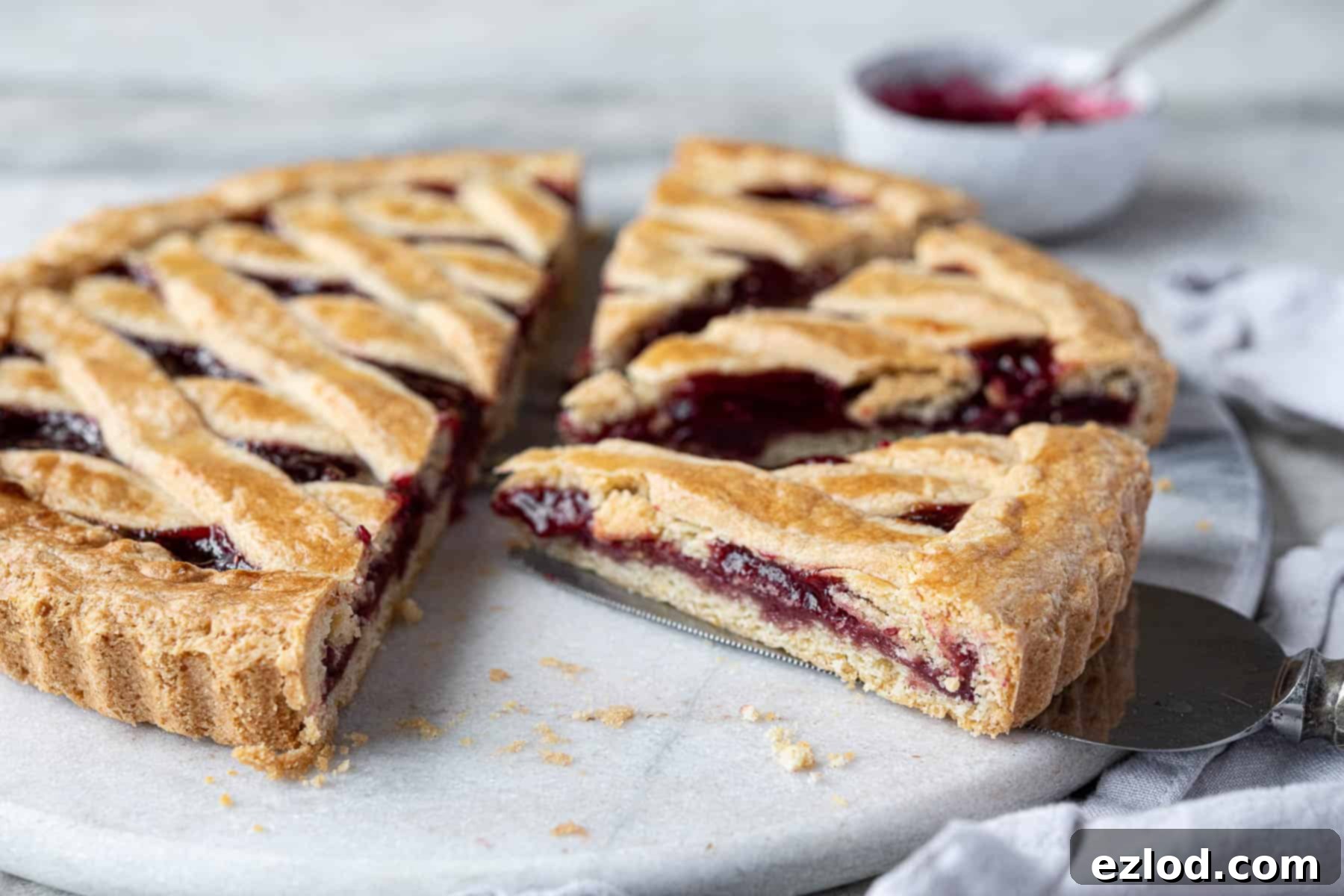
If you’ve had the pleasure of trying this wonderful vegan jam crostata recipe, I would absolutely love to hear about your experience! Please take a moment to rate it, leave a comment with your thoughts, or share your delicious creation on Instagram by tagging @domestic_gothess and using the hashtag #domesticgothess. Your feedback, creative interpretations, and shares truly make my day and inspire more delicious vegan recipes!
All images and content presented on Domestic Gothess are protected by copyright. If you wish to share this recipe, kindly do so by utilizing the provided share buttons. Please refrain from screenshotting or posting the recipe or content in its entirety. Instead, include a direct link back to this post to share the full recipe and details with others. Your understanding and support in respecting content creators’ work are greatly appreciated!

Print
Vegan Jam Crostata
Ingredients
- 300 g (2 ½ cups) plain (all-purpose) flour
- 1 teaspoon baking powder
- 100 g (½ cup) caster (superfine) sugar
- pinch salt
- finely grated zest of 1 large lemon
- 170 g (scant ¾ cup) vegan block butter cold and cubed
- about 3 Tablespoons cold non-dairy milk or water
- 300 g (10 oz) good quality jam
- non-dairy milk for brushing
Instructions
-
Place the flour, baking powder, sugar, salt and lemon zest in a large bowl and mix well.
-
Add the cold, cubed butter and rub it in using your fingertips until the mixture resembles fine breadcrumbs and no lumps of butter remain.
-
Gradually mix in enough cold milk or water to bring the pastry togther into a ball. Shape it into a disc, wrap and refrigerate for at least an hour, until the pastry is firm enough to roll out.
-
Section off ¼ of the pastry and return it to the fridge. Roll out the rest of the pastry on a floured surface into a large round about ½ cm thick.
-
Carefully transfer the pastry to an approx 25 cm/10 in round loose bottomed tart tin and gently press it into the corners of the tin. Trim off the excess pastry.
-
Roll out the reserved pastry, along with any scraps. Use a pizza wheel, dough cutter or sharp knife to slice 10 strips of pastry.
-
Fill the tart case with the jam. Lay 5 of the pastry strips spaced apart across the top in one direction.
-
Lay the remaining 5 pastry strips on top, going in a different direction to form a lattice pattern.
-
Trim the ends of the pastry strips then fold the edge of the base over the ends of the lattice, sealing them in.
-
Place the crostata in the fridge or freezer for 15 minutes while you preheat the oven to 180°C/160°C fan/350°F/gas mark 4.
-
Gently brush the exposed pastry with milk then bake for 35-40 minutes until deep golden.
-
Cool in the tin for 30 minutes then carefully remove the crostata from the tin and place on a wire rack to cool completely.
Notes
- See post above for tips, details and step-by-step photos.
- All of my recipes are developed using grams, and as with all of my baking recipes I really do recommend using the metric measurements with a digital scale rather than the cup coversions. Cups are a wildly inaccurate measuring system and you will get far better, more consistent results using a scale, not to mention that it is also easier and less messy than cups!
